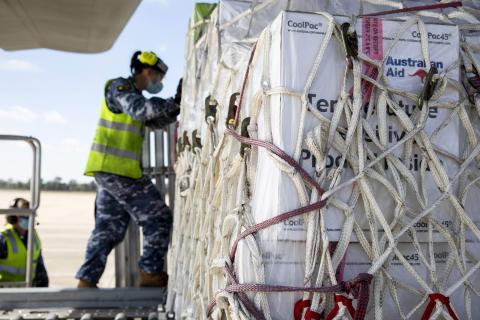Of Papua New Guinea's population of about 8 million, 80% are rural villagers who produce most of their own food. This makes them vulnerable to extreme weather events. Reports of severe impact on food crops from the recent frosts and ongoing drought in Papua New Guinea are coming from most areas in the Central Highlands. This is where over 40%, or more than 2.5 million, of rural villagers live.

The most serious damage has occurred above 2200m, but many reports are from lower altitudes in the highlands and even from some lowland locations. This impact, in late August, is already greater than at similar stages in previous frosts and droughts, suggesting that this may be a more severe event than the major food shortages of 1997. These required large scale interventions from both the Australian and Papua New Guinean Governments to avoid widespread famine.
It's likely that the current crisis is going have a serious impact on the national economy, both the resource and agricultural sectors. In 1997, the Ok Tedi mine was closed for six months because of low water levels in the Fly Rivera, and the Porgera mine was closed for six weeks. This year, the Ok Tedi mine has already been closed for more than a month due to low water levels in the Fly River, which has prevented copper ore from being shipped out. The drought prevents supplies, including helicopter fuel, being brought by barge to Kiunga, which affects gas exploration in that region.
A long drought is likely to have significant impact on oil palm production, particularly on New Ireland and New Britain and possibly in Oro and Milne Bay provinces. There are already reports of some oil palm blocks in West New Britain being destroyed by fire. [fold]
A major impediment to planning a relief effort is the lack of current meteorological data. In 1970, 330 stations were recording data, but during the last major drought in 1997, we were able to obtain current rainfall data from about 30 locations. This figure is now less than 10.
More detailed information is urgently needed, both to understand what is happening and to plan relief efforts. We could then extrapolate more broadly, albeit from a limited number of locations. For example, if we knew that repeated severe frosts had destroyed sweet potato and other food crops as low as 2000m in Enga and Western Highlands provinces, we could be reasonably certain that the outcome would be similar at many other locations in these and the two adjacent provinces.
Similarly, if people were suffering from lack of water for drinking and processing sago in parts of inland Western Province, then similar scenarios would be likely in many other inland locations there and the adjacent Gulf Province.
Residents living in or near the affected areas, and field assessments by agricultural, water supply and health specialists, could provide the detailed information necessary to assist the Papua New Guinean Government in assessing the situation and formulating a plan to reduce the suffering for rural villagers and others.
Relief could include helping people move to other locations where they maintain ties, which is the traditional coping mechanism at such times for villagers living at very high altitude. It could also include the provision of water containers, water purification units, food aid and medical assistance, as the drought will almost certainly increase the incidence of malaria, typhoid, diarrhoea and possibly dysentery.
At this stage the Government has not requested assistance with drought relief, as it did in 1997, so that international development partners, NGOs and the churches could assist with transport, food aid, water purification, medical supplies and logistics.*
That in itself will be complicated:
- Many transport networks in rural PNG are run down to some degree. Some locations that could be reached by road in 1997 can now only be accessed by helicopter or on foot. Many airstrips in remote locations are no longer serviceable.
- The PNG health system is under considerable strain and, in many rural locations, the air posts and rural health sub-centres fundamental to the system no longer function.
- The forthcoming national election in 2017 has the potential to distort food distribution efforts, as potential candidates and current serving politicians seek to gain an advantage from this climate-induced crisis.
In 1997, it was the action of the rural villagers and their urban-based wantoks which prevented widespread famine. Villagers and their urban relatives purchased over 80% of the additionally-imported rice. This resilience, and the wantok safety net, remain intact and will be critical in saving many lives again in 2015 and beyond.
The 1997 event scarred the memories of millions of Papua New Guineans: many people will be aware of what is happening and know what to expect in coming months. They will also know what they have to do to look after their families, unlike in 1997 when most people had not experienced the previous nation-wide food shortages of 1941.
We too must recall the lessons of 1997, so we can help them in their distress.
*Correction: To the authors knowledge. Any assistance to villagers by the PNG Government, international development partners, NGOs and the churches with transport, food aid, water purification, medical supplies and logistics will be complicated.
Photo courtesy of Flickr user Department of Foreign Affairs and Trade.
